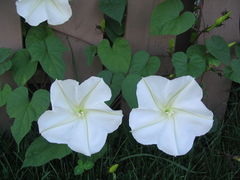Ipomoea alba
| Ipomoea alba subsp. var. | Moonflower, Moon Vine, Giant White Moonflower, Belle de nuit | |||||||||||||||||||||||||||||||||||||||||||||||||||||||
|---|---|---|---|---|---|---|---|---|---|---|---|---|---|---|---|---|---|---|---|---|---|---|---|---|---|---|---|---|---|---|---|---|---|---|---|---|---|---|---|---|---|---|---|---|---|---|---|---|---|---|---|---|---|---|---|---|

|
|
| ||||||||||||||||||||||||||||||||||||||||||||||||||||||
| ||||||||||||||||||||||||||||||||||||||||||||||||||||||||
Ipomoea alba, sometimes called the moonflower (but not to be confused with the other species also called moonflower) or moon vine, is a species of night-blooming morning-glory, native to tropical and subtropical regions of the New World, from northern Argentina north to Mexico and Florida. Though formerly classified as genus Calonyction, species aculeatum, it is now properly assigned to genus Ipomoea, subgenus Quamoclit, section Calonyction.[1]
It is a perennial herbaceous liana growing to a height of 5-30 m tall with twining stems. The leaves are entire or three-lobed, 5-15 cm long, with a 5-20 cm long stem. The flowers are fragrant, white or pink, and large, 8-14 cm diameter. The flowers open quickly in the evening and last through the night, remaining open until touched by the morning sun. On overcast days, the blossoms may remain open for longer. The flowers also tend to remain open longer during cool temperatures - which may also cause the segments to snag or tear as they open.
The name Moonflower derives from their blooming in the evening and their being round in shape like a full moon.
Cultivation
The species is widely cultivated as an ornamental plant for its flowers. In areas too cold for winter survival, it can be grown as an annual plant. Since it is of tropical origin, it flowers best under a summer short day photoperiod. Though it can be successfully flowered in the north, its flowering is impaired by excessively long summer days. Thus, it often does not set buds and bloom until early autumn when daylight length is once again near 12 hours. In some areas it is an invasive species which can cause problems in agricultural settings.
Propagation
Propagation is usually by seed. The seed resembles a small brownish nut, and should be nicked with a file and then soaked overnight before planting.
Pests and diseases
Cultivars
- 'Giant White' - extra large white flowers up to 6 in (15cm)AH.
Gallery
If you have a photo of this plant, please upload it! Plus, there may be other photos available for you to add.
-
photo 1
-
photo 2
-
photo 3
References
External links
- w:Ipomoea alba. Some of the material on this page may be from Wikipedia, under the Creative Commons license.
- Ipomoea alba QR Code (Size 50, 100, 200, 500)
